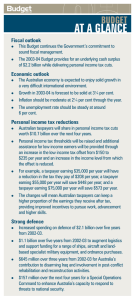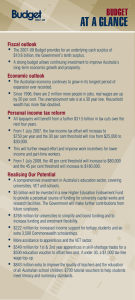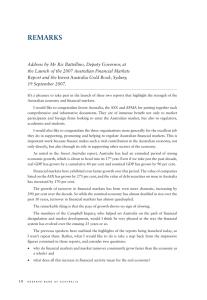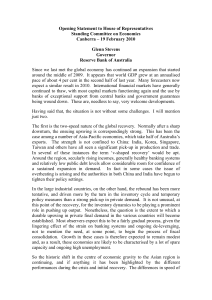Shifting Currents in the Global Economy
advertisement
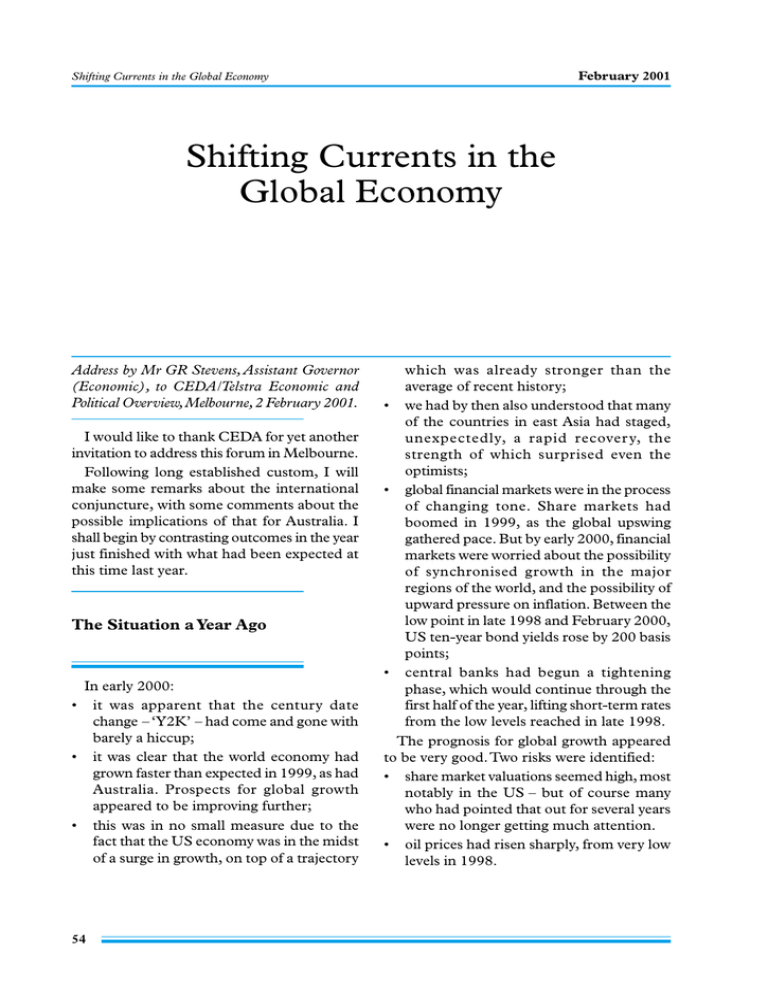
February 2001 Shifting Currents in the Global Economy Shifting Currents in the Global Economy Address by Mr GR Stevens, Assistant Governor (Economic), to CEDA/Telstra Economic and Political Overview, Melbourne, 2 February 2001. I would like to thank CEDA for yet another invitation to address this forum in Melbourne. Following long established custom, I will make some remarks about the international conjuncture, with some comments about the possible implications of that for Australia. I shall begin by contrasting outcomes in the year just finished with what had been expected at this time last year. The Situation a Year Ago In early 2000: • it was apparent that the century date change – ‘Y2K’ – had come and gone with barely a hiccup; • it was clear that the world economy had grown faster than expected in 1999, as had Australia. Prospects for global growth appeared to be improving further; • this was in no small measure due to the fact that the US economy was in the midst of a surge in growth, on top of a trajectory 54 which was already stronger than the average of recent history; • we had by then also understood that many of the countries in east Asia had staged, unexpectedly, a rapid recover y, the strength of which surprised even the optimists; • global financial markets were in the process of changing tone. Share markets had boomed in 1999, as the global upswing gathered pace. But by early 2000, financial markets were worried about the possibility of synchronised growth in the major regions of the world, and the possibility of upward pressure on inflation. Between the low point in late 1998 and February 2000, US ten-year bond yields rose by 200 basis points; • central banks had begun a tightening phase, which would continue through the first half of the year, lifting short-term rates from the low levels reached in late 1998. The prognosis for global growth appeared to be very good. Two risks were identified: • share market valuations seemed high, most notably in the US – but of course many who had pointed that out for several years were no longer getting much attention. • oil prices had risen sharply, from very low levels in 1998. Reserve Bank of Australia Bulletin February 2001 2000 turned out to be a blue-ribbon year for growth of the global economy. It appears that world GDP as measured by the IMF expanded by something between 41/2 and 5 per cent (Graph 1). This was the strongest growth for over a decade. It is worth repeating that what at one stage looked like it might be a very serious slump in global growth in late 1998 and 1999 was averted. The total effect of the Asian crisis and all the subsequent events – the relapse of Japan into recession, the Russian crisis, the problems in financial markets after LTCM and so on – seems to have been to push global growth about one percentage point below average for one year in 1998.The difference was made up by 2000. Much (though not all) of this was due to the exceptional strength of the US economy, as everyone knows. During 2000, it was no surprise that attention focused heavily on the US. It always does by virtue of the United States’ status as the largest economy in the world, but there was an additional reason for attention in the year just ended, because of the unfolding saga of the ‘new economy’. Discussion of the new economy was spurred by rapid technological progress delivering rising aggregate productivity growth, new products, and high levels of investment. There was intense discussion of the appropriate valuations to be placed on the anticipated streams of earnings from those investments. There was perhaps somewhat less attention paid in some cases than there should have been to the fact that, as in any venture, all of this involved a not inconsiderable degree of risk. It was against this general background that a feature of 2000 was the behaviour of asset markets, and capital flows. By the late 1990s asset markets had already placed a very high valuation on the earnings from the supply and use of technology products by American firms (and their counterparts in other countries). Yet these assets, and US assets in general, continued for some time to be very attractive to investors, including those in other regions of the world.There have been substantial flows of capital to the United States over recent years, first attracted by, and in turn helping to sustain, the gains in American asset values (Graph 2). These took the form of both portfolio flows, and direct investments – through merger and acquisitions. These flows increased the resources available to the United States.They meant that Americans could both consume and invest at a greater rate than would be allowed by their own (not insubstantial) resources alone. The counterparts to these capital flows have been a decline in the share of current income saved Graph 1 Graph 2 2000 Outcomes Net Capital Flows to the United States World GDP Growth % % IMF forecasts 1 year ago 5 5 Latest Per cent of GDP % % 4 4 Total 4 4 30 year average 3 3 2 2 3 3 2 2 1 1 FDI 1 0 1 1988 1990 Source: IMF 1992 1994 1996 1998 2000 0 0 0 -1 -1 1990 1992 1994 1996 1998 2000 55 February 2001 Shifting Currents in the Global Economy by US citizens (Graph 3), a widening in the US current account deficit (Graph 4), and a strengthening in the US dollar against most other currencies. Graph 3 US Wealth and Saving Ratio % Personal saving (RHS, per cent of disposable income) 6.0 10.5 5.5 7.0 fortunes of the Australian dollar during 2000 as well. By year’s end, the US share market had recorded a decline from the figure at the end of the previous year, for the first time since 1994 (Graph 5). If we may proxy the ‘high-tech’ sector by the NASDAQ index, it had fallen by almost 50 per cent since its peak in March, though some of that decline has been reversed during the past month. Finally, the US dollar did not continue the relentless upward march of the first half of the year, and other currencies found more suppor t, including our own. Wealth-to-income ratio (LHS) 5.0 Graph 5 3.5 4.5 0.0 Share Prices January 1995 = 100 Index 4.0 1960 1968 1976 1984 1992 -3.5 2000 Graph 4 Index NASDAQ 600 600 500 500 400 400 300 US Current Account Balance 300 Per cent of GDP Wilshire 5000 % % 0 0 -1 -1 -2 -2 -3 -3 -4 -4 -5 -5 1990 1992 1994 1996 1998 2000 US share prices reached a peak in March, and fell in stages through the rest of the year as the tide of optimism about earnings gradually turned, and people became more conscious of risk. But exchange rates continued on their earlier course for longer, with the result that the euro, introduced in 1999, spent almost the first two years of its life declining, influenced by capital flows towards the US. As the Governor has pointed out, elements of this story help to explain the 56 200 200 S&P/ASX 200 100 0 100 0 1995 1997 1999 2001 The weaker trend in share prices was probably re-inforced by the fact that the US economy, having been expected to slow down for four years, finally did (Graph 6). The changed picture for wealth of American households has probably in turn played some role in softening demand growth. US GDP growth in the second half of 2000 declined to less than 3 per cent, and to a bit over 1 per cent in the last quarter. This compares with the 6 per cent pace in the first half of 2000, and an average of over 41/2 per cent since the end of 1996. A range of recent data for the US economy suggest that, first, in the classical ‘old economy’ areas – like car manufacturing – conditions have been weakening for some time and, second, that the boom in the ‘tech’ sector, which for a time offset this weakness, is now slowing. Reserve Bank of Australia Bulletin February 2001 Graph 6 Graph 7 United States – Real GDP Oil Prices Percentage change Log scale % % 6 6 Year-ended 4 US$/ barrel 40 US$/ barrel 40 30 30 20 20 4 10 year average 2 2 0 0 Quarterly -2 -2 1991 1993 1995 1997 1999 2001 Source: Datastream As a result of these developments, people have recently, and rather suddenly, become much more pessimistic about near-term US prospects. In response to the shifting balance of risks – less risk of accelerating inflation and more risk of weakness in aggregate demand – the Federal Reserve has cut short-term interest rates in a fairly aggressive fashion. Financial markets have priced-in further reductions. There has been quite a significant decline in interest rates at the longer end of the US yield curve as well. While all this was occurring, oil prices continued to feature. Identified a year ago as a risk to the global economy, the price for West Texas oil reached US$37 per barrel in September, or over $60 a barrel in Australian dollar terms (Graph 7). The rising prices called forth additional supply from the OPEC cartel, and also a release of oil from official US stocks. Nonetheless, for much of the year rising oil prices worked to dampen household spending power, and raise costs of production. In the United States in particular, but generally in energy-using countries around the world, this effect works to lower profits, and dampen aggregate demand. Such forces have played a role in creating the slowdown now being talked about so widely. More recently, 10 1981 1985 1989 1993 1997 10 2001 oil prices have declined somewhat, though they remain above the average for the past decade or so. In February 2001, then, things look rather different to the way they looked a year ago. At the risk of some over-simplification, we might say that in February 2000, the US economy was accelerating; global growth was picking up; share prices were high and rising; global interest rates were tending to rise; and the US dollar was strengthening. Oil prices had increased and had further to go. Now, the US economy has (finally) slowed markedly, and forecasts for global growth are being reduced. US share prices have fallen appreciably, heavily in some areas. US interest rates have peaked and come down noticeably, and the US dollar has declined a little. Oil prices have declined, though they remain higher than they were during most of the 1990s. Whereas a year ago all the talk was about the extent of higher production by the OPEC countries, now production has been reduced. This is probably best interpreted as an attempt, in recognition of softening prospects for demand, to manage supply in an effort to prevent a repeat of the collapse of oil prices which occurred in 1998. 57 February 2001 Shifting Currents in the Global Economy Outlook for 2001 What does this signal about the year ahead? The consensus among forecasters about international growth has been marked down over recent months. This is mainly a result of the noticeably weaker prognosis for the US economy, but a softening in some of the short-run data coming out of Europe has been taken to imply somewhat weaker growth there in 2001 than last year. The Japanese economy remains brittle. Hence after running at 41/2 to 5 per cent in 2000, world GDP growth is expected by international forecasters to be more like 33/4 per cent in 2001 (Graph 8). Experience in observing the evolution of forecasts in the past suggests to me that the process of downward revision to growth forecasts may well have a bit further to go. Even if that were to be the case, however, so that world growth ended up being, say, 31/4 to 31/2 per cent, that would still be close to the average outcome over the past thirty years. That would be a notable slowdown from 2000 outcomes, but not too bad. Graph 8 World GDP Growth % % IMF forecasts Oct 2000 5 Latest 5 * 4 4 30 year average 3 3 2 2 1 1 0 0 1989 * Estimate Source: IMF 1991 1993 1995 1997 1999 2001 One has to admit that a considerable degree of uncertainty is attached to this prognosis. This is quite common at turning points. Everyone can tell something is happening which represents an important change in the environment, but it is very hard to be dogmatic about how big the change will turn out to be. The reason for that is that outcomes depend to no small extent on the psychology of participants in markets and economies generally, and on the response of policies. These sorts of forecasts presume that the US economy does not encounter a prolonged slump, but rather regains some speed after a soft first half of 2001.1 People will rightly point to the weakness of recent data in that country and worry about a more protracted and deeper slowdown than the consensus of forecasters predicts. They might also point to the Fed’s recent actions and say that this shows the Fed is worried. It certainly shows that the Fed has discerned, and responded to, a significant change to the balance of risks. But that action itself, and the fact that interest rates right across the US yield cur ve have fallen substantially, will help to contain incipient forces for weakness in the US. And there are already some early signs that the interest-sensitive housing sector of the US economy may be beginning to respond to improved conditions for good-quality borrowers. These are still quite tentative at this stage, but it would not be surprising to see further such signs emerge over coming months. I think, then, that it is reasonable to conclude that the declines in US interest rates have already probably improved the prospects for US and global growth in 2002. Many forecasters are assuming further reductions in interest rates. I would conjecture that while forecasts for international growth in 2001 might be further revised down, a year from now we might well be observing revisions in the opposite direction for 2002. 1. It also presumes that there is not a significant reversal of the recent oil price decline. That is a reasonable assumption to make in my view, but as before there is the risk that it could be wrong. The implications of that are well understood so I will not spend any time here going through them. 58 Reserve Bank of Australia Bulletin February 2001 Closer to home, what is envisaged by these forecasters for the Asian region? The short answer is somewhat lower growth than last year, as some of the leading economies ease back from the break-neck pace which characterised the early part of their recovery from the crisis. This is to be expected. It has in fact been anticipated for a time now, and has probably taken a little longer to occur than originally expected. Overall growth is thought likely to continue, though with some quite distinct differences between individual countries within the region. One area to watch is the electronics sector. Some of Asia’s fastest growing economies have benefited greatly from the expansion in production of IT components (Graph 9). In Korea, Singapore, Malaysia and Taiwan, for example, half or more of the expansion in industrial production since the low point in 1998 has been in the electronics sector. This has been the supply-side counterpart of the rapid run-up in investment in information technology by industrial economies, especially the US, in recent years. In any long run, such investment seems likely to continue to occur, spurred in part by the continually declining cost and rising productivity of such equipment. In the short term, however, should there be a temporary lull in IT spending around the world, some of Asia’s economies would be vulnerable to a weakening in growth. Were that to occur, of course, then it would presumably be open to those countries to adopt policies which would work to dampen the effect of export losses, in part by expanding domestic demand. Given appropr iate responses, there is no reason to think that any repeat of the 1997 crisis is on the cards. Implications for Australia Over the past year, we expected to see a deceleration in domestic demand in Australia, and strong export growth. The exact extent of both has been hard to untangle because of the distortions to behaviour occasioned by tax reform, and the Olympic Games. These were only temporary factors but their echoes are still being felt. Overall, however, that general feature of the economy – slowing domestic demand and strengthening exports – is readily observable. Australian exporters in particular have seen growth in export incomes which has rarely been exceeded over the past four decades (Graph 10). For the year to November, for example, expor ts rose by 25 per cent (excluding identifiable effects of the Olympics). Growth rates on an annual basis of between 20 and 30 per cent have been Graph 9 Graph 10 Non-Japan Asia – Industrial Production Growth in Exports 1995 = 100 Index Index Total Per cent of GDP % % 6 6 Prices 140 140 5 5 To Sep 4 120 3 3 2 2 1 1 120 100 100 Excluding electronics 0 0 Volume -1 80 4 1995 1996 1997 1998 1999 2000 80 -2 1960 1968 1976 -1 1984 1992 -2 2000 59 February 2001 Shifting Currents in the Global Economy maintained for the past eight months. And in volume terms the net export component of demand growth has turned from negative to positive. Given even moderate global growth, and an exchange rate which, while above very low levels seen a few months ago, is still conferring a distinct competitive advantage to Australian exporters, we could reasonably expect quite good gains in exports in the coming year, even if they did not match the very strong pace of the past year. The obvious risks to this can be identified. A global slump, if it were to develop, would be a serious problem for Australia – as it would be for all exporting countries. This is always true. It seems at present, moreover, that the risk of this has once again increased, as it did just over two years ago. What is important in such a situation is the capacity and willingness of the major countries to counter, if needed, contractionary forces with judicious use of expansionary macro policies. How much scope there is for such actions usually depends on the extent of imbalances existing in economies. In the US and Europe, with inflation relatively low, at least one potential imbalance does not appear to be the problem it has been at other times. In the US, if the current rate of core inflation of about 21/2 per cent turns out to be a cyclical peak, it will be the lowest one for more than 30 years. European inflation is even lower. Hence there is no major impediment here to the use of expansionary policies if they are needed. US monetary policy has already turned in that direction, and US fiscal policy appears likely to follow suit. European fiscal policy is likely to move in that direction too over the year ahead. It has to be admitted that serious problems linger in Japan – but they are probably no worse than they have been for some years. Some people will no doubt point to the US current account deficit as a significant imbalance. To the extent that there is a re-appraisal of the attractiveness of US assets, the capital flows which were the counterpart of the widening of the US current account will diminish. This will need to be associated 60 with some shifts in American consumption and investment patterns. It is obviously possible that such adjustments, particularly if they were forced to be abrupt, could be difficult to achieve and disruptive. The rest of the world has a vital interest in the US economy managing such adjustments in as smooth a manner as possible. At the same time, it is worth pointing out that, other things equal, some reduction in capital flows to the US is no bad thing for other countries who seek capital to fund growth – like Australia. A continuation of the earlier trend towards more and more internationally mobile capital being attracted to the US, chasing continually escalating asset values which required ever higher growth of future earnings to be sustained, would surely have not been in the interests of the US economy or of the rest of the world. To the extent that unrealistic assessments of the potential returns from technology and associated industries drew real factors of production – capital, labour and intellectual effort – to that sector and away from other ‘traditional’ areas, there was a potentially quite serious misallocation of resources occurring. Its continuation would probably have meant an increasingly difficult adjustment task for the Australian economy, as we would effectively have faced a continual increase in the cost of capital. From this perspective, some part at least of the recent re-appraisal about the US economy is probably to be welcomed. This is not in any way to deny the seriousness of a real slump in the US economy, were that to occur. Conclusion Overall then, the global scene is less benign than it seemed a year ago. 2000 was a very good year for global growth (even if not for growth in every individual country). 2001 was always going to see some moderation in growth. A shock to oil prices was always likely to make it harder for industrial countries to Reserve Bank of Australia Bulletin continue the exceptional run of strong growth with very low inflation they had enjoyed in the late 1990s. And the size of the run-up in US asset values and the additional capital flows associated with it always carried the possibility of disruption, both on the way up and the way down. Hence 2001 has started on a much more uncertain note, and there actually is, to use the forecaster’s cliché, more than the usual degree of uncertainty about the outlook. Whether the world economy slows noticeably, but to a still quite reasonable rate of growth, or to something much lower, remains to be seen. In the former case, with a still very competitive exchange rate, Australian exporters should still be well placed. In the February 2001 latter case, we would have to assume they would find things much more difficult. In either case, the fact that the big one-offs in the Australian economy seen in 2000 have already occurred, rather than being in prospect, is probably a bonus. An additional advantage is the absence of major imbalances in the domestic economy.Whatever conditions may come our way, we are as well placed to weather them as we could hope to be. The one thing which perhaps could be said with confidence is that, whereas 2000 was a year in which big events at home were the primary focus of economic discussion, in 2001 it appears that attention will turn once again, if it has not already, to events abroad. R 61
